Samurai Banners (Furin kazan, Toho/Mifune, 1969) opens with gorgeous widescreen black & white cinematography recapturing the glory-days of adult jidai-geki samurai films in the hands of such directors as Kobayashi & Kurosawa.
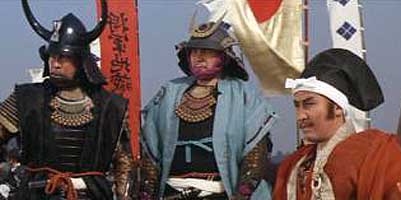 We're introduced to two ronin in a condition of beggary. One of them (Ken Ogata) is talked into pretending to attack Nobukato Itagaki (Kanemon Nakamura), an elderly vassal of the lord of Kai, while the other intercedes. They will put on a charade that when revealed will have impressed the vassal with their skills, & score both of them a position in a clan. We're introduced to two ronin in a condition of beggary. One of them (Ken Ogata) is talked into pretending to attack Nobukato Itagaki (Kanemon Nakamura), an elderly vassal of the lord of Kai, while the other intercedes. They will put on a charade that when revealed will have impressed the vassal with their skills, & score both of them a position in a clan.
But Kansuko Yamamoto (Toshiro Mifune) who laid out this simple plan has no intention of playing it through as mere charade. Instead, he lops off his fellow ronin's arm, chases him down & kills him, then posing as the vassal's savior is given a position in the province of Kai, where he is immediately recognized as a genius at military tactics.
That opening scene with Mifune doing his basic "Yojimbo" routine could've been set in the Tokugawa Period of peacefulness & jobless ronins. But the story is actually set in the 16th Century Warring States period, & the personal drama of the opening sequence is shunted aside for a sweeping epic of war. Not only do we not again see black & white cinematography in this rousing full color epic, but in its two hour forty-five minutes the story will rarely again be so up close & personal, as it addresses the Larger Scheme of Things. Even Toshiro Mifune's Kansuke, having been introduced as a man whose "tactics" include an easy capacity for cruelty & deception, is for much of the rest of the film so overburdened with excess of costume that he cannot use his physique for maximum effect, whereas in his best performances he tends to be more physical than actorly.
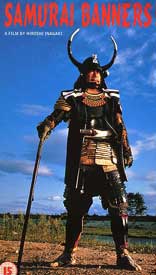 Toshiro's character design has him scarred on the forehead & limping, always leaning on a staff (the historical Kansuke was missing an arm & a leg). Kinnosuke Nakamura is Lord Takeda of Tai, a landlocked province that given the unsettled age has known a considerable degree of peace & prosperity. But Lord Takeda dreams of a warlord's glory in a warring age, & when he takes on Kansuke as a military tactician, it is because he sees immediately that his own fate need not to be that of a backwoods lord. Fief by fief, Kansuke has a plan intended to spread Takeda's domain to the coast, & ultimately to unite the entirety of Japan. Toshiro's character design has him scarred on the forehead & limping, always leaning on a staff (the historical Kansuke was missing an arm & a leg). Kinnosuke Nakamura is Lord Takeda of Tai, a landlocked province that given the unsettled age has known a considerable degree of peace & prosperity. But Lord Takeda dreams of a warlord's glory in a warring age, & when he takes on Kansuke as a military tactician, it is because he sees immediately that his own fate need not to be that of a backwoods lord. Fief by fief, Kansuke has a plan intended to spread Takeda's domain to the coast, & ultimately to unite the entirety of Japan.
Sato Masura's soundtrack of violins & brass often sounds more like a wild west western than a samurai epic, & Hiroshi Inagaki's old-fashioned & conservative manner of making a film has "safe commercial project" written all over it. From Toshiro Mifune's own production company, Mifune as a producer had neither the daring nor the artistic temperament to do more, & Itagaki was the perfect choice for such big safe products. On one level it is a very successful film that despite its length never gets boring, but on the larger level of the great artistry Japanese cinema so often achieves, this one's not up that high.
The Japanese title Furin kazen means "Wind, Fire, Forest, Mountain," the symbols used on the war banners of the Takada clan. To great extent Kansuke orchestrated his position in the Takada clan because he loved the clan symbols, which represented the four points of the compass that he believed he could unite. He also fell in love with the countryside of Kai. In devoting himself wholeheartedly to Lord Takeda, he is really devoting himself to the ultimate dream of vassalage, to serve a lord so perfectly & well that his lord rises above all others.
To some extent Lord Shingen Takeda is Kansuke's puppet-daimyo, but only because Takeda recognizes what Kansuke can do for him. Because Kansuke easily uses tricks, lies, & deceits to win battles, he could almost come off as a villain. But because his genius is aimed entirely at service to Lord Takeda & his dream of a united Japan, there is always something selfless about his extravagant intentions.
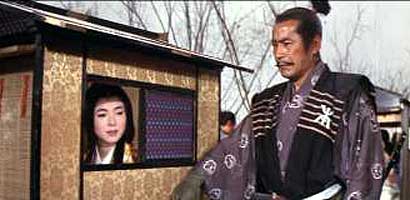 Visually a lot of the details of this film are accurate, & the history depicted is often close to authentic, as Shingen Takeda did rise to just this degree of power in much the manner shown, & the battlefields recreated are none of them fictionalized. The primary source for this history is a contemporary document Ehon-Shingen-Ichidaiki, a pictorial biography of the daimyo Shinren Takada. Little re-enactments like the use of a gigantic halbard which takes three men to weild it as they mow down men & horses, may look odd to the point of humor, but was a real battlefield method. The huge-horned kabuto (helmet) worn by Kansuke through much of the film may look like an exaggerated prop, but is entirely authentic. Visually a lot of the details of this film are accurate, & the history depicted is often close to authentic, as Shingen Takeda did rise to just this degree of power in much the manner shown, & the battlefields recreated are none of them fictionalized. The primary source for this history is a contemporary document Ehon-Shingen-Ichidaiki, a pictorial biography of the daimyo Shinren Takada. Little re-enactments like the use of a gigantic halbard which takes three men to weild it as they mow down men & horses, may look odd to the point of humor, but was a real battlefield method. The huge-horned kabuto (helmet) worn by Kansuke through much of the film may look like an exaggerated prop, but is entirely authentic.
Kansuke also loves beauty -- the beauty of the countryside & vistas of Kai, of poetry, of a flowering tree, or of a young princess. One aspect of the film is its biggest fiction, from the novel Furin kazan by Yasushi Inoue. The details of the life of Princess Yu (Yoshiko Sakuma) are a romantic invention, understated due to the focus on battlefields & warrior tactics & big costumes. The film bares up to a second viewing, however, mainly because it is possible to not notice on first viewing that Kansuke is a man in love, but at second viewing there are some interesting character motivations that keep the sweepingly epic events from containing nothing personal.
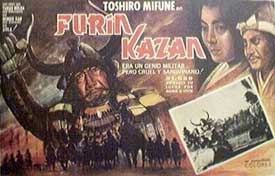 His love for Princess Yu is unusual in that it becomes instantly subordinant to his devotion to his lord, & his dream-ideal is for the woman he loves to marry the man he serves. Because Lord Takeda was her father's betrayer & enemy, Princess Yu would like to avenge herself upon him, but finds herself attracted to him in spite of herself, so that she lives with continuous conflict. Similarly she perceives Kansuke as her guide & protector, though he first came to her as a foe; & he in turn would willingly die in her service. His love for Princess Yu is unusual in that it becomes instantly subordinant to his devotion to his lord, & his dream-ideal is for the woman he loves to marry the man he serves. Because Lord Takeda was her father's betrayer & enemy, Princess Yu would like to avenge herself upon him, but finds herself attracted to him in spite of herself, so that she lives with continuous conflict. Similarly she perceives Kansuke as her guide & protector, though he first came to her as a foe; & he in turn would willingly die in her service.
When she has a son, the boy is not the oldest nor born of the first wife, so not Takeda's heir. Kansuke regards the infant boy as being as much his child as Lord Takeda's, & the forcefully united Japan Kansuke envisions he believes will be inherited by Princess Yu's son. Even Lord Takeda comes to realize that much of what he & his tactician accomplished was due to their mutual love for Princess Yu, an acknowledgement he makes without censor or jealousy, it's merely a fact.
There is a much smaller performance at the fringe of the story which I quite liked, that of Kazuo Nakamura as Nobusato Itagaki, the son of the elder vassal who originally brought Kansuke into the clan. With minimal dialogue, Kazuo's subtle presence provides a side-story of heroism & affection worthy of special notice, even though the more gigantic presences of Kinnosuke & Toshiro easily hide Kazuo's interesting presence.
Political & interpersonal conflicts build & climax but of course Kansuke's dream of a united Japan turns out to be beyond his reach, & the Warring States era will last into another century. In the history of successful "failures," the brilliant general Kansuke is depicted as one of the most complex & intriguingly heroic, & the role fits perfectly Toshiro Mifune's limited but thrilling acting range.
copyright © by Paghat the Ratgirl
|
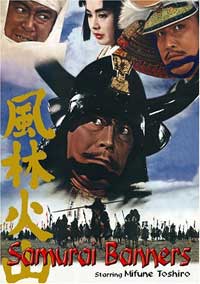
 We're introduced to two ronin in a condition of beggary. One of them (Ken Ogata) is talked into pretending to attack Nobukato Itagaki (Kanemon Nakamura), an elderly vassal of the lord of Kai, while the other intercedes. They will put on a charade that when revealed will have impressed the vassal with their skills, & score both of them a position in a clan.
We're introduced to two ronin in a condition of beggary. One of them (Ken Ogata) is talked into pretending to attack Nobukato Itagaki (Kanemon Nakamura), an elderly vassal of the lord of Kai, while the other intercedes. They will put on a charade that when revealed will have impressed the vassal with their skills, & score both of them a position in a clan. Toshiro's character design has him scarred on the forehead & limping, always leaning on a staff (the historical Kansuke was missing an arm & a leg). Kinnosuke Nakamura is Lord Takeda of Tai, a landlocked province that given the unsettled age has known a considerable degree of peace & prosperity. But Lord Takeda dreams of a warlord's glory in a warring age, & when he takes on Kansuke as a military tactician, it is because he sees immediately that his own fate need not to be that of a backwoods lord. Fief by fief, Kansuke has a plan intended to spread Takeda's domain to the coast, & ultimately to unite the entirety of Japan.
Toshiro's character design has him scarred on the forehead & limping, always leaning on a staff (the historical Kansuke was missing an arm & a leg). Kinnosuke Nakamura is Lord Takeda of Tai, a landlocked province that given the unsettled age has known a considerable degree of peace & prosperity. But Lord Takeda dreams of a warlord's glory in a warring age, & when he takes on Kansuke as a military tactician, it is because he sees immediately that his own fate need not to be that of a backwoods lord. Fief by fief, Kansuke has a plan intended to spread Takeda's domain to the coast, & ultimately to unite the entirety of Japan. Visually a lot of the details of this film are accurate, & the history depicted is often close to authentic, as Shingen Takeda did rise to just this degree of power in much the manner shown, & the battlefields recreated are none of them fictionalized. The primary source for this history is a contemporary document Ehon-Shingen-Ichidaiki, a pictorial biography of the daimyo Shinren Takada. Little re-enactments like the use of a gigantic halbard which takes three men to weild it as they mow down men & horses, may look odd to the point of humor, but was a real battlefield method. The huge-horned kabuto (helmet) worn by Kansuke through much of the film may look like an exaggerated prop, but is entirely authentic.
Visually a lot of the details of this film are accurate, & the history depicted is often close to authentic, as Shingen Takeda did rise to just this degree of power in much the manner shown, & the battlefields recreated are none of them fictionalized. The primary source for this history is a contemporary document Ehon-Shingen-Ichidaiki, a pictorial biography of the daimyo Shinren Takada. Little re-enactments like the use of a gigantic halbard which takes three men to weild it as they mow down men & horses, may look odd to the point of humor, but was a real battlefield method. The huge-horned kabuto (helmet) worn by Kansuke through much of the film may look like an exaggerated prop, but is entirely authentic. His love for Princess Yu is unusual in that it becomes instantly subordinant to his devotion to his lord, & his dream-ideal is for the woman he loves to marry the man he serves. Because Lord Takeda was her father's betrayer & enemy, Princess Yu would like to avenge herself upon him, but finds herself attracted to him in spite of herself, so that she lives with continuous conflict. Similarly she perceives Kansuke as her guide & protector, though he first came to her as a foe; & he in turn would willingly die in her service.
His love for Princess Yu is unusual in that it becomes instantly subordinant to his devotion to his lord, & his dream-ideal is for the woman he loves to marry the man he serves. Because Lord Takeda was her father's betrayer & enemy, Princess Yu would like to avenge herself upon him, but finds herself attracted to him in spite of herself, so that she lives with continuous conflict. Similarly she perceives Kansuke as her guide & protector, though he first came to her as a foe; & he in turn would willingly die in her service.